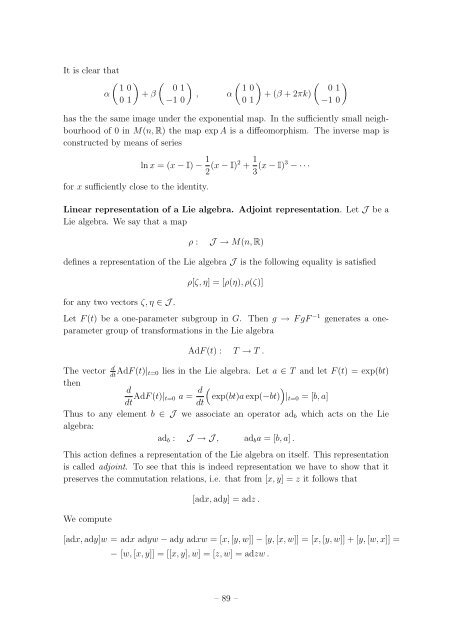Student Seminar: Classical and Quantum Integrable Systems
Student Seminar: Classical and Quantum Integrable Systems
Student Seminar: Classical and Quantum Integrable Systems
Create successful ePaper yourself
Turn your PDF publications into a flip-book with our unique Google optimized e-Paper software.
It is clear that<br />
( ) 1 0<br />
α + β<br />
0 1<br />
( ) 0 1<br />
, α<br />
−1 0<br />
( ) 1 0<br />
+ (β + 2πk)<br />
0 1<br />
( ) 0 1<br />
−1 0<br />
has the the same image under the exponential map. In the sufficiently small neighbourhood<br />
of 0 in M(n, R) the map exp A is a diffeomorphism. The inverse map is<br />
constructed by means of series<br />
for x sufficiently close to the identity.<br />
ln x = (x − I) − 1 2 (x − I)2 + 1 3 (x − I)3 − · · ·<br />
Linear representation of a Lie algebra. Adjoint representation. Let J be a<br />
Lie algebra. We say that a map<br />
ρ : J → M(n, R)<br />
defines a representation of the Lie algebra J is the following equality is satisfied<br />
for any two vectors ζ, η ∈ J .<br />
ρ[ζ, η] = [ρ(η), ρ(ζ)]<br />
Let F (t) be a one-parameter subgroup in G. Then g → F gF −1 generates a oneparameter<br />
group of transformations in the Lie algebra<br />
AdF (t) : T → T .<br />
The vector d AdF (t)| dt t=0 lies in the Lie algebra. Let a ∈ T <strong>and</strong> let F (t) = exp(bt)<br />
then<br />
d<br />
dt AdF (t)| t=0 a = d (<br />
)<br />
exp(bt)a exp(−bt) | t=0 = [b, a]<br />
dt<br />
Thus to any element b ∈ J we associate an operator ad b which acts on the Lie<br />
algebra:<br />
ad b : J → J , ad b a = [b, a] .<br />
This action defines a representation of the Lie algebra on itself. This representation<br />
is called adjoint. To see that this is indeed representation we have to show that it<br />
preserves the commutation relations, i.e. that from [x, y] = z it follows that<br />
We compute<br />
[adx, ady] = adz .<br />
[adx, ady]w = adx adyw − ady adxw = [x, [y, w]] − [y, [x, w]] = [x, [y, w]] + [y, [w, x]] =<br />
− [w, [x, y]] = [[x, y], w] = [z, w] = adzw .<br />
– 89 –

















